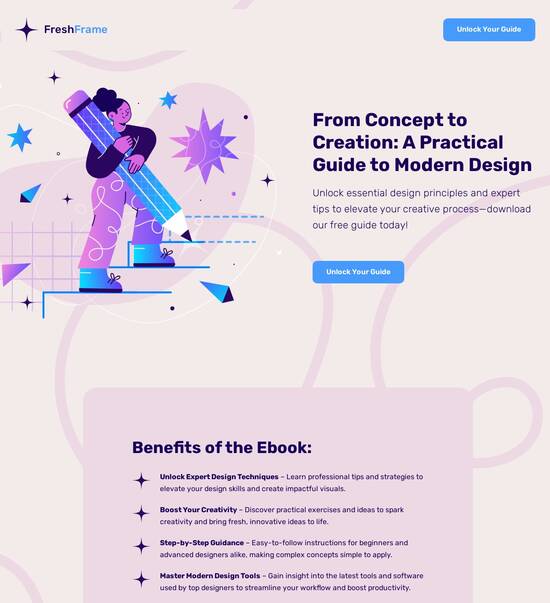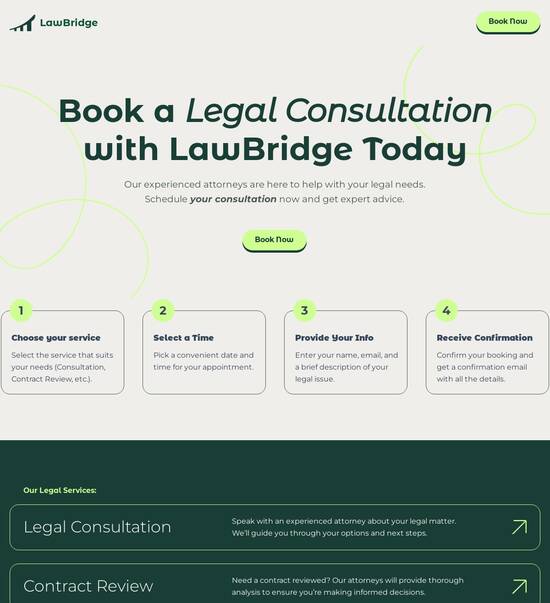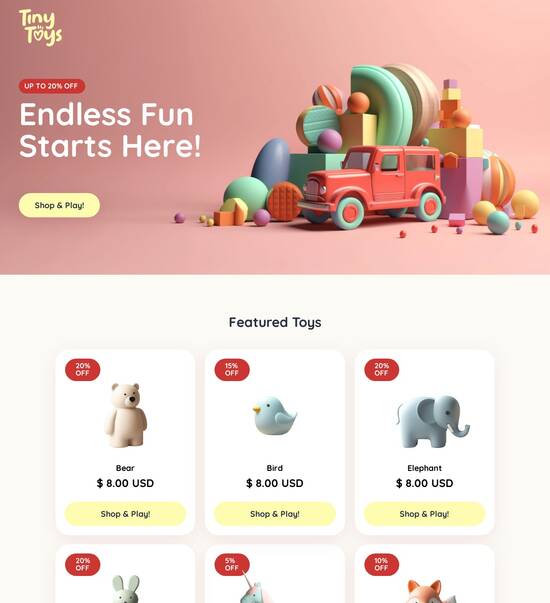
HTML page template for scenic train rides
Use TemplateAbout template
Engage your audience like never before with stunning landing page templates for scenic train rides. Make your online presence unforgettable!
Recommended templates

Easy to build without coding
With the intuitive drag-and-drop builder, anyone on your team can create high-converting pages without any knowledge of code or design. Make enhancements to your landing page with custom widgets using Javascript, HTML/CSS, or third-party scripts.

Multiple layouts for any industry and goal
Select from 500+ landing page layouts built to boost conversions across industry-specific scenarios. Customize them by adjusting fonts, adding images, and generating on-brand content with the AI assistant. Quickly scale with Instablocks® and Global Blocks that you can save, reuse, and update globally.

Loads fast and looks polished on any device
Every template is responsive, which means they present professionally on any device and load blazingly fast with our Thor Render Engine. You can also power them up with Google AMP technology to deliver an unparalleled mobile experience and drive higher conversions.

Robust analytics & experimentation
Get real-time updates and reporting across all your devices, showing the number of visitors, conversions, cost-per-visitor, and cost-per-lead. Launch AI-powered experiments, run A/B tests, and use heatmaps to analyze user behavior, then optimize your landing page to maximize conversions.







Easy to build without coding
With the intuitive drag-and-drop builder, anyone on your team can create high-converting pages without any knowledge of code or design. Make enhancements to your landing page with custom widgets using Javascript, HTML/CSS, or third-party scripts.
Multiple layouts for any industry and goal
Select from 500+ landing page layouts built to boost conversions across industry-specific scenarios. Customize them by adjusting fonts, adding images, and generating on-brand content with the AI assistant. Quickly scale with Instablocks® and Global Blocks that you can save, reuse, and update globally.
Loads fast and looks polished on any device
Every template is responsive, which means they present professionally on any device and load blazingly fast with our Thor Render Engine.
Robust analytics & experimentation
Get real-time updates and reporting across all your devices, showing the number of visitors, conversions, cost-per-visitor, and cost-per-lead. Launch AI-powered experiments, run A/B tests, and use heatmaps to analyze user behavior, then optimize your landing page to maximize conversions.
All the features you need to build lead-generating landing pages
Explore more featuresLearn how to build top-performing landing pages for any goal
FAQs
Leading the way in building high-performing landing pages





Mastering landing page optimization with Instapage
Landing pages are the cornerstone of effective digital marketing campaigns, and with Instapage, you can create high-converting pages that drive engagement and leads. This guide will provide you with a step-by-step approach to leveraging Instapage’s features to craft landing pages tailored to your specific audience in various verticals, from education to financial services.
Understanding landing page essentials
An effective landing page is not just about aesthetics; it requires strategic planning and execution. Understanding your audience's needs and the specific purpose of your landing page is crucial. Here are some key elements to consider:
- Clear Call-To-Action (CTA): Your landing page should prominently feature a straightforward CTA that instructs visitors on the next steps.
- Compelling Headline: A strong, benefit-driven headline can grab attention and encourage users to stay on the page.
- High-Quality Visuals: Use engaging images or videos that relate to your offer, improving the overall appeal.
- Trust Indicators: Show testimonials, reviews, or certifications to build credibility with your audience.
Step 1: Choose your template
Instapage provides 100+ ready-to-use, high-converting templates suitable for various campaign styles. Here’s how to effectively select a template:
- Identify your campaign goal: Consider whether your primary aim is lead generation, product sales, or event registrations.
- Review past successful designs: Check templates that have yielded high conversions in similar campaigns to ensure effectiveness.
- Customize with your branding: Make sure to customize elements such as colors and fonts to match your brand identity.
Step 2: Optimize for conversions
Once your template is selected, the next step involves optimization. This is where Instapage’s built-in features come into play:
- A/B Testing: Utilize A/B testing to experiment with different versions of your landing page elements to see which performs better.
- Analytics Dashboard: Monitor metrics like visitor behavior and conversion rates to assess the effectiveness and tweak accordingly.
- Heatmaps: Use detailed heatmaps to visualize where users are clicking and spending time on your page, guiding further enhancements.
Step 3: Personalize user experiences
Personalization can significantly increase engagement. With Instapage, you can implement dynamic content that tailors the message to specific audience segments. Consider these strategies:
- Dynamic Text Replacement: Automatically change text based on the ad or search term that led users to your landing page.
- AdMaps Integration: Align advertising campaigns with unique landing pages to ensure consistency and relevance for each audience.
- Audience Segmentation Tracking: Use data tools to monitor how different audience segments interact with your content for targeted follow-ups.
By effectively using these steps, you can maximize the ROI of your marketing efforts. Instapage not only simplifies the landing page creation process but ensures every aspect is optimized for performance.
Ready to elevate your digital marketing campaigns? Sign up for Instapage today and start creating powerful landing pages that convert!
People also ask about HTML page template for scenic train rides
HTML page template for scenic train rides
Capturing the essence of scenic train rides
Scenic train rides provide a unique travel experience that blends the beauty of nature with the thrill of rail travel. These journeys often take passengers through breathtaking landscapes, from majestic mountains to picturesque riversides, allowing them to relax and take in the views. Not only do they serve as a means of transportation, but they also offer a chance to connect deeply with the environment while enjoying the leisurely pace of the journey.
Popular scenic train routes can be found around the globe, each offering something special. For example, the Glacier Express in Switzerland provides stunning views of the Alps, while the Rocky Mountaineer traverses the Canadian Rockies. In the U.S., the Coast Starlight route is renowned for its scenic coastline views from Los Angeles to Seattle. These spectacular routes contribute to the allure of scenic train travel, and as such, it’s essential to effectively showcase them through an engaging HTML page template.
Glacier Express (Switzerland)
Rocky Mountaineer (Canada)
Coast Starlight (USA)
The Jacobite (Scotland)
Bernina Express (Switzerland)
A well-designed HTML page is vital for enhancing user experience and engagement. An appealing page draws users in and keeps their attention, making them more likely to explore further. An effective use of visuals and storytelling can significantly boost digital marketing efforts, helping travelers envision their journey before they book, thereby facilitating decision-making.
The structure of an HTML page template
An HTML page template for scenic train rides should include several key elements to ensure it is functional and visually appealing. The header is the top area of the page, where branding and navigation reside. This space typically includes the logo, site navigation menu, and possibly a call to action like 'Book Now' or 'Learn More.' A well-organized header provides an immediate understanding of the page’s focus and accessibility.
The main content area is where the scenic experience is evoked. Here, you can highlight stunning visuals of the train routes, include descriptions of the landscapes, and share stories from travelers. A footer is also essential, providing contact information, links to social media, and other relevant resources. A clear structure not only improves the aesthetic of the page but also aids in navigation, making for a seamless user experience.
Header – includes branding and navigation
Main Content Area – showcases scenic experiences
Footer – provides contact info and links
Utilizing semantic HTML is important for accessibility. This technique involves using HTML tags that convey meaning about the content they enclose, such as , , , , and . Not only does this promote better SEO, but it also enhances compatibility for screen readers, making your content accessible to users with disabilities.
Integrating multimedia with rich visuals
When emphasizing scenic train rides, integrating images and videos is crucial. The right images can transport visitors to beautiful locations before they even set foot on a train. When selecting images, aim for high-resolution photographs that capture vibrant landscapes and happy travelers. Additionally, consider embedding videos that showcase scenic rides, testimonials from passengers, or a virtual tour of the train's amenities, providing an immersive experience for potential travelers.
To ensure that visuals are effective, proper image optimization is key. Large image files can slow down page loading times and lead to a poor user experience. Compress images without sacrificing quality and utilize formats like JPEG for photographs and PNG for graphics. Tools like TinyPNG or ImageOptim can help with this process. For videos, using embed codes from platforms like YouTube or Vimeo simplifies integration and maintains fast loading speeds.
Choosing high-quality images for stunning visuals
Embedding video testimonials or scenic videos
Optimizing images for faster loading times
Using embed codes for seamless video integration
Dynamic interaction with JavaScript
JavaScript plays a vital role in enhancing user engagement on your HTML page template. By incorporating interactive elements like slideshows and galleries, you can present visual content in a captivating manner. An image carousel, for instance, allows users to scroll through breathtaking images of scenic landscapes effortlessly, and this can significantly improve time spent on your site.
To further enhance navigation and usability, tools like dropdown menus or sticky headers can be included. Implementing `document.addEventListener` allows for smooth and responsive interactions. This feature can track various user events, such as clicks and hovers, and provides valuable data on user behavior, allowing you to fine-tune the page for maximum impact.
Incorporating interactive elements like slideshows
Utilizing tools to improve navigation and usability
Understanding event listeners in JavaScript
Implementing user interactions through clicks and hovers
Ensuring optimal page performance
Page load optimization is essential for retaining user interest. Techniques such as minifying CSS and JavaScript can significantly reduce the file size, which in turn enhances load times. Minification involves removing unnecessary characters in the code without affecting functionality. Another strategy involves using a Content Delivery Network (CDN) to distribute assets more efficiently and implementing lazy loading, which only loads images or videos when they are required as a user scrolls down the page.
With the help of developer tools, you can analyze performance metrics and identify loading bottlenecks. Monitoring site speed and analyzing how users interact with the page will provide insight into areas for improvement. Tools like Google PageSpeed Insights can assist in evaluating your performance and offering actionable suggestions.
Minification of CSS and JavaScript for faster load times
Using CDN and lazy loading for asset management
Evaluating performance with developer tools
Identifying bottlenecks for improvement
Seamless load and user experience with `DOMContentLoaded`
`DOMContentLoaded` is an essential event in JavaScript that fires when the initial HTML document has been completely loaded and parsed. This differs from other loading events like `load`, which waits for all resources to finish loading, including images and style sheets. By understanding this distinction, you can execute scripts right after the DOM is ready, ensuring a smoother user experience by preventing blocked content.
Best practices for script placement involve deciding between inline and external scripting. Often, external scripts are preferred for usability and load times, as they allow the browser to cache the file. Additionally, asynchronous loading techniques can be utilized to prevent scripts from interfering with the initial load of the page, helping to maintain fast loading speeds.
Understanding the `DOMContentLoaded` event and its benefits
Using inline vs external scripting effectively
Asynchronous loading techniques for optimal performance
Crafting a narrative through design
The design of your HTML page template should reflect the scenic experience you are promoting. The choice of color palette is essential; selecting colors inspired by the landscapes can evoke emotions and create a connection with the viewer. Earthy tones can stimulate feelings of tranquility, while vibrant colors can convey excitement. A cohesive theme throughout the page will reinforce your brand and message, enhancing the overall narrative of the journey.
Typography also plays a critical role in readability and appeal. Selecting fonts that are easy to read and harmonize with the overall design is crucial. Moreover, establishing a hierarchy in text presentation will guide the reader’s eye and help convey your message succinctly. Combining these design elements will not only attract visitors but will also encourage them to explore further.
Choosing colors that reflect the scenic landscape
Creating emotional connections through design
Selecting fonts that enhance readability
Establishing a hierarchy in text presentation
Trust and credibility through user reviews
Incorporating customer testimonials on your HTML page can have a significant impact on persuading potential travelers. The influence of social proof can prompt users to trust your services, understanding that others have enjoyed the scenic rides you offer. A dedicated section that showcases reviews, which may include snippets of written feedback or star ratings, can create a sense of authenticity and reliability.
Implementing a star rating widget can enhance this credibility. Prospective customers might be more inclined to book their trip after observing positive ratings and the experiences of previous passengers. Visual representations of customer experiences will not only reinforce trust but also enrich the interactive quality of the page.
The impact of social proof on decision making
Incorporating a dedicated section for reviews
Implementing star rating widgets for enhanced credibility
Visual representation of customer experiences
Responsive design for all devices
With the rise of mobile users, optimizing your HTML page template for mobile devices is crucial. Studies have shown that a significant portion of website traffic now comes from smartphones and tablets. A responsive design ensures that your content is easily accessible, regardless of the device being used. Implementing responsive layout design strategies is essential for retaining visitor interest and minimizing bounce rates.
Utilizing CSS media queries is one effective strategy to achieve adaptive designs that work across various device sizes. Testing tools are also essential to confirm cross-device compatibility. Platforms like BrowserStack can allow users to preview how their site will appear on different devices, ensuring a consistent experience for all users.
Statistics on mobile users and browsing habits
Strategies for responsive layout design
Using CSS media queries for adaptive designs
Testing tools for cross-device compatibility
Copyright and content licensing considerations
When creating an HTML page for scenic train rides, it's important to understand copyright laws and content licensing considerations. Using Creative Commons licensed content can enable you to utilize visuals and text while respecting the rights of creators. It is crucial to recognize the types of content that may require licenses, such as images, music, and written content, and also to properly credit sources when necessary.
There are various platforms where you can find royalty-free images and resources, such as Unsplash or Pexels. It's also vital to protect your original content from potential theft by implementing security measures like watermarking images and adding clear copyright statements. By doing so, you maintain professional integrity while enriching your HTML page with valuable content.
Types of content that need licenses
Where to find royalty-free images and resources
Techniques to prevent content theft
Acknowledging source materials correctly
Real-world applications and case studies
To illustrate the effectiveness of a well-crafted HTML page template for scenic train rides, it's helpful to examine successful marketing campaigns in this niche. For instance, a case study on the Glacier Express demonstrates how stunning visuals and strategic user engagement led to increased bookings. The integration of videos featuring live scenery and passenger testimonials made a compelling case for potential clients considering their next vacation.
Interviews with industry experts further underline essential design decisions. Market leaders often emphasize the importance of storytelling and immersive experiences. These insights underline the future trends in digital marketing for scenic travel, emphasizing personalized content and multimedia storytelling as critical components of effective campaigns.
Case studies highlighting effective HTML page designs
Key takeaways and lessons learned from successful campaigns
Insights from market leaders on design decisions
Future trends in digital marketing for scenic travel
Final thoughts
The realm of scenic travel marketing continually evolves, influenced by technological advancements and user expectations. As highlighted throughout this article, effective design principles and techniques are crucial for creating an impactful HTML page template for scenic train rides. Understanding your audience and leveraging multimedia can significantly enhance engagement and conversion.
Moreover, continuous learning and adaptation are essential in this competitive landscape. Embracing the latest trends and best practices not only maximizes the potential of your web presence but can also foster deeper connections with customers, ultimately driving bookings and loyalty.
Ready to skyrocket conversions?
Supercharge your ad campaigns with high-performing landing pages
Get started














